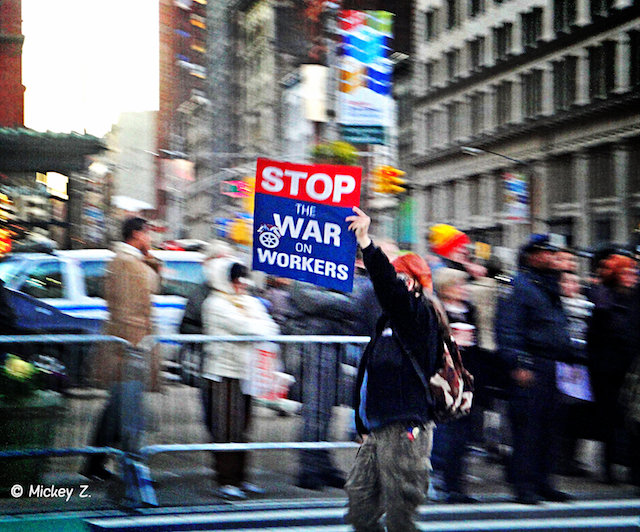Militant Movie Making: 'Salt of the Earth'
By Mickey Z.
02 February, 2014
World News Trust

Photo credit: Mickey Z.
“Watching a film should feel like you just tore a hole out of the air and the void caught fire.” - Josh Fox
Name the best-known early 1950s motion picture with a union theme? Easy. That would be On the Waterfront.
But Waterfront was not the early 1950s motion picture with a union theme that Noam Chomsky called, “one of the greatest films ever made… couldn’t get it out of my mind for weeks.”
Nope, that early 1950s motion picture with a union theme would be the criminally neglected but crucially essential 1953 film, Salt of the Earth.
Made by a group of McCarthy-era, blacklisted filmmakers, Salt of the Earth tells the story of New Mexico zinc miners -- and their families -- struggling against their bosses for a better life. The film is based on the real-life struggle of MMSW Local 890, which went on strike against the Empire Zinc Corporation in 1950.
“Shortly after the strike had begun, an injunction prohibited men from walking the picket lines,” writes Tony Pecinovsky in People’s Weekly World. “Women soon replaced their brothers, sons, husbands, and fathers -- an action of major significance, especially since corporate America had little tolerance for people of color, especially women of color, standing up for their rights.”
Narrated by a character appropriately named Esperanza, the wife of a striking miner, Salt of the Earth features a cast made up almost entirely of those who actually participated in the strike and is a feminist movie before such a thing had a name.
Equally as impressive is the manner in which revolutionary film was completed against all odds. Production began on Jan. 20, 1953, and the Hollywood Reporter soon announced: “H’wood Reds are shooting a feature-length anti-American racial issue propaganda movie.”
The outcry carried all the way to Congress where Donald Jackson, a member of the House Un-American Activities Committee (HUAC), promised: “I shall do everything in my power to prevent the showing of a communist-made film in the theaters of America.”
Rosaura Revueltas, the woman who played Esperanza, was deported to Mexico during production on a trumped-up immigration charge (her passport hadn’t been stamped upon entering the U.S.).
“The film’s director, Herbert Biberman, spent six months in jail for refusing to testify before HUAC,” adds Pecinovsky. “Several key personnel on the film were found in contempt of Congress when they refused HUAC’s badgering as well. The film crew was barred from laboratories, sound studios, and other facilities normally used by filmmakers. No Hollywood labs would process the film and the projectionist’s union refused to show it.”
Salt of the Earth made its theatrical debut in March 1954 and won the International Grand Prize from the Academie du Cinema de Paris in 1955. Like the characters in the film and the real-life workers those characters were based on, the filmmakers had emerged triumphant in what Pecinovsky calls a story “about racism, sexism, chauvinism, red-baiting, union busting, censorship and courage; the courage of ordinary people, workers and filmmakers, standing together in solidarity.”
Deborah Rosenfelt, author of a book about the film, has written: “The continuing significance of Salt of the Earth for our own time arises from its attempt -- rare in works of art in any medium -- to integrate the struggles of women, of an ethnic minority, and workers … Salt of the Earth … inspires belief in the possibility of genuine social change. It encourages us to act on that belief. Seeing it has made a difference in more than one life; my own was one of them.”
Please allow me to suggest:
Watch Salt of the Earth free online now.
Share its message far and wide.
Get busy creating your own radical art.
#shifthappens
Note: To continue conversations like this, come see Mickey Z. in person on Feb. 5 at Bluestockings Bookstore in NYC.
Order “Occupy this Book: Mickey Z. on Activism” here.
Mickey Z. is the author of 11 books, most recently the novel Darker Shade of Green. Until the laws are changed or the power runs out, he can be found on a couple of obscure websites called Facebook and Twitter. Anyone wishing to support his activist efforts can do so by making a donation here
©WorldNewsTrust.com
Comments are moderated
